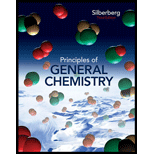
Concept explainers
In each pair, choose the larger of the indicated quantities or state that the samples are equal:
(a) Entities: 0.4 mol of
(b) Grams: 0.4 mol of
(c) Moles: 4.0 g of
(f) Molecules: 1.0 g of
(h) Grams:
(a)
Interpretation:Out of
Concept introduction:One mole of any substance contains Avogadro number of particles equivalent to
Answer to Problem 3.89P
Explanation of Solution
Since equal
(b)
Interpretation: Out of
Concept introduction: The formula to convert moles to mass in grams is as follows:
Answer to Problem 3.89P
Explanation of Solution
The formula to convert moles to mass in grams is as follows:
Moles of
Molar mass of
Substitute the values in above formula.
The formula to convert moles to mass in grams is as follows:
Moles of
Molar mass of
Substitute the values in above formula.
(c)
Interpretation: Out of
Concept introduction: The formula to convert moles to mass in grams is as follows:
Answer to Problem 3.89P
Explanation of Solution
The formula to convert mass in grams to moles is as follows:
For
Given mass is
Molar mass is
Substitute the value in above formula.
For
Given mass is
Molar mass is
Substitute the value in above formula.
(d)
Interpretation: Out of
Concept introduction: The formula to convert moles to mass in grams is as follows:
Answer to Problem 3.89P
Explanation of Solution
The formula to convert moles to mass in grams is as follows:
Moles of
Molar mass of
Substitute the values in above formula.
The formula to convert moles to mass in grams is as follows:
Moles of
Molar mass of
Substitute the values in above formula.
(e)
Interpretation: Out of
Concept introduction: One mole of any substance contains Avogadro number of particles equivalent to
The formula to convert moles to molecules is as follows:
Answer to Problem 3.89P
Explanation of Solution
The formula to convert moles to molecules insodium chlorate is as follows:
For sodium chlorate
Total moles is
Substitute the value in above formula.
For magnesium chloride
The formula to convert moles to molecules inmagnesium chloride is as follows:
Total moles is
Substitute the value in above formula.
(f)
Interpretation:Out of
Concept introduction: One mole of any substance contains Avogadro number of particles equivalent to
The formula to determine number of molecules is as follows:
Answer to Problem 3.89P
Explanation of Solution
The formula to determine number of molecules is as follows:
For
Given mass is
Molar mass is
Substitute the value in above formula.
For
Given mass is
Molar mass is
Substitute the value in above formula.
(g)
Interpretation:Out of
Concept introduction: One mole of any substance contains Avogadro number of particles equivalent to
The formula to determine number of molecules is as follows:
Answer to Problem 3.89P
Explanation of Solution
The formula to evaluate moles from molarity is given as follows:
Value of
Value of
Substitute the values to calculate
The conversion factor to convert
Hence convert
The formula to determine moles is as follows:
For
Given mass is
Molar mass is
Substitute the value in above formula.
(h)
Interpretation: Out of
Concept introduction:One mole has always
Answer to Problem 3.89P
Explanation of Solution
Since, one mole of any substance contains Avogadro number of particles equivalent to
Want to see more full solutions like this?
Chapter 3 Solutions
Principles of General Chemistry
- b. CH3 H3C 'N' H3C CH3 CN Ph 1. OH N 2. H2O2, Pyridinearrow_forwardFor each of the Followin, moleaks draw all OF The Resonance contributing stuluctures and compare these three molecules in terms of Resonance stabilization 1-C-1 a. b. H A-C+ О 112-1 C. F-C-F Farrow_forwarda. Explain Why electron withdrawing groupe tend to be meta-Directors. Your answer Should lyclude all apropriate. Resonance contributing Structures 6. Explain why -ll is an ortho -pura drccton evon though chlorine has a very High Electronegativityarrow_forward
- Question 1. Please predict the products for each of the following reactions. Clearly show the regiochemistry (Markovnikov vs anti-Markovnikov) and stereochemistry (syn- vs anti- or both). If a mixture of enantiomers is formed, please draw all the enantiomers.arrow_forwardElectrochemistry. Briefly describe the Donnan potential.arrow_forwardIndicate what the Luther equation is used for?arrow_forward
- Indicate one aspect that benefits and another that makes it difficult to use the hydroquinone electrode to measure pH.arrow_forwardAt an electrified interface according to the Gouy-Chapman model, what types of interactions do NOT occur between the ions and the solvent according to this theory?arrow_forwardPlease predict the products for each of the following reactions. Clearly show the regiochemistry (Markovnikov vs anti-Markovnikov) and stereochemistry (syn- vs anti- or both). If a mixture of enantiomers is formed, please draw all the enantiomers. Hint: In this case you must choose the best answer to demonstrate the stereochemistry of H2 addition. 1.03 2. (CH3)2S BIZ CH₂OH 2. DMS KMnO4, NaOH ΖΗ Pd or Pt (catalyst) HBr 20 1 HBr ROOR (peroxide) HO H-SO HC 12 11 10 BH, THE 2. H2O2, NaOH Brz cold HI 19 18 17 16 MCPBA 15 14 13 A Br H₂O BH3⚫THF Brz EtOH Pd or Ni (catalyst) D₂ (deuterium) 1. Os04 2. H2O2 CH3CO3H (peroxyacid) 1. MCPBA 2. H₂O* H B + H H H "H C H H Darrow_forward
 ChemistryChemistryISBN:9781305957404Author:Steven S. Zumdahl, Susan A. Zumdahl, Donald J. DeCostePublisher:Cengage Learning
ChemistryChemistryISBN:9781305957404Author:Steven S. Zumdahl, Susan A. Zumdahl, Donald J. DeCostePublisher:Cengage Learning Chemistry: An Atoms First ApproachChemistryISBN:9781305079243Author:Steven S. Zumdahl, Susan A. ZumdahlPublisher:Cengage Learning
Chemistry: An Atoms First ApproachChemistryISBN:9781305079243Author:Steven S. Zumdahl, Susan A. ZumdahlPublisher:Cengage Learning
 Chemistry for Engineering StudentsChemistryISBN:9781337398909Author:Lawrence S. Brown, Tom HolmePublisher:Cengage Learning
Chemistry for Engineering StudentsChemistryISBN:9781337398909Author:Lawrence S. Brown, Tom HolmePublisher:Cengage Learning Chemistry: Principles and ReactionsChemistryISBN:9781305079373Author:William L. Masterton, Cecile N. HurleyPublisher:Cengage Learning
Chemistry: Principles and ReactionsChemistryISBN:9781305079373Author:William L. Masterton, Cecile N. HurleyPublisher:Cengage Learning Chemistry & Chemical ReactivityChemistryISBN:9781337399074Author:John C. Kotz, Paul M. Treichel, John Townsend, David TreichelPublisher:Cengage Learning
Chemistry & Chemical ReactivityChemistryISBN:9781337399074Author:John C. Kotz, Paul M. Treichel, John Townsend, David TreichelPublisher:Cengage Learning





